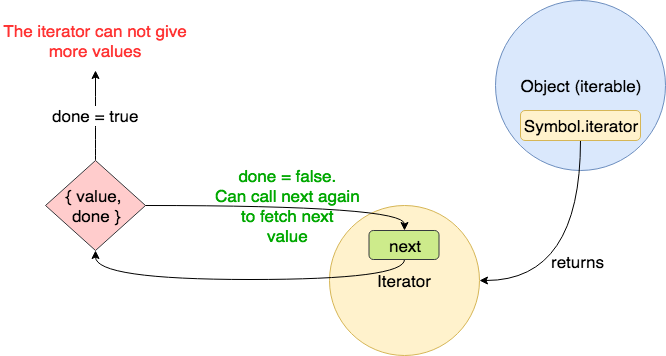리스트 순회
ES5에서의 리스트 순회
// 리스트 순회
const list = [1, 2, 3];
for (var i = 0; i < list.length; i++) {
console.log(list[i]);
}
// 유사배열 순회
const str = "abc";
for (var i = 0; i < str.length; i++) {
console.log(str[i]);
}프로퍼티에 의존하여 어떻게 순회할 지 명령적으로 표현됨
ES6+에서의 리스트 순회
// 리스트 순회
const list = [1, 2, 3];
for (const num of list) {
console.log(num);
}
// 유사배열 순회
const str = "abc";
for (const char of str) {
console.log(char);
}보다 선언적이고 간결해짐 -> 문법을 보기 좋게 다듬은 것이 전부 일까?
ES6+에서는 순회를 어떻게 추상화하였는가?
for ... of 문의 순회 방식은 무엇일까?
const arr = [1, 2, 3];
const set = new Set([1, 2, 3]);
const map = new Map([
["a", 1],
["b", 2],
["c", 3],
]);
for (const el of arr) console.log(el); // 1, 2, 3
for (const el of set) console.log(el); // 1, 2, 3
for (const el of map) console.log(el); // ["a", 1], ["b", 2], ["c", 3]ES6 이전의 순회 방식은 index를 key로 두고 index의 값을 1씩 증가하면서 순회한다.
그렇다면 ES6+ 에서도 동일한 방식으로 순회를 할까?
답은 '아니오'이다.
set[0]; //undefined
set[1]; //undefined
set[2]; //undefined
map[0]; // undefined
map[1]; // undefined
map[2]; // undefined만약 index을 키로 두고 사용하는 방식이라면 위의 예시에서 undefined가 출력되지 않았을 것이다. 그렇다면 for...of의 순회 방법은 무엇일까?
iterable / iterator

iterable
- iterator을 리턴하는 [Symbol.iterator] 메서드를 가진 객체
iterator
{value: , done: } 객체를 리턴하는 next() 메서드를 가진 객체
{value, done} 객체
- value : 현재 값이 담겨있다.
- done : 불리언 값을 가지며 반복의 종료를 결정한다.
직접 만들어보며 이해해보자!
직접 이터러블 객체를 만들어보면서 이터러블 개념을 이해해보자
let iterableObj = {
from: 1,
to: 5,
};
//for (const num of iterableObj)가 작동하여 num = 1,2,3,4,5로 순회하게 해보자.- iterable은 iterator 객체를 리턴하는 [Symbol.iterator] 메서드를 가져와야한다.
iterableObj[Symbol.iterator] = function () {
const iterator = {};
return iterator;
};- iterator은 {value, done}객체를 리턴하는 next() 메소드를 가져야한다.
iterableObj[Symbol.iterator] = function () {
const iterator = {
next() {
return { value: null, done: null };
},
};
return iterator;
};- value는 현재 값을 가지고, done은 종료 조건을 갖늗다.
iterableObj[Symbol.iterator] = function () {
const iterator = {
current: this.from,
last: this.to,
next() {
if (this.current <= this.last) {
return {
value: this.current++,
done: false,
};
} else {
return { done: true };
}
},
};
return iterator;
};- 완성 코드
let iterableObj = {
from: 1,
to: 5,
};
iterableObj[Symbol.iterator] = function () {
const iterator = {
current: this.from,
last: this.to,
next() {
if (this.current <= this.last) {
return {
value: this.current++,
done: false,
};
} else {
return { done: true };
}
},
};
return iterator;
};
for (const num of iterableObj) {
console.log(num);
}
// 1 2 3 4 5for...of루프는 [Symbol.iterator] 메서드를 통해 iterator객체를 생성하고 iterator는 done이 true가 될 떄까지 next()를 호출하여 순회시킨다.
전개 연산자
iterable 객체는 전개 연산자(...)를 사용할 수 있다.
